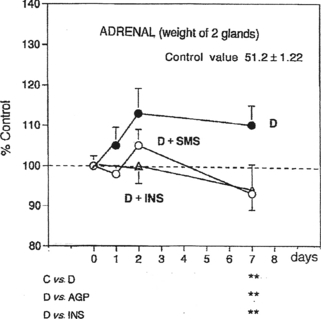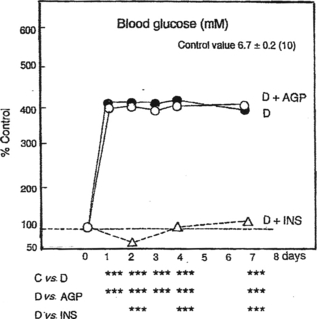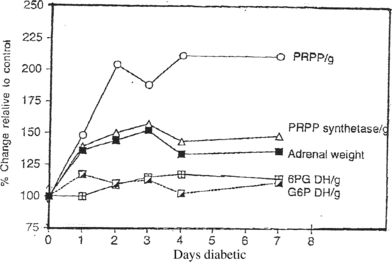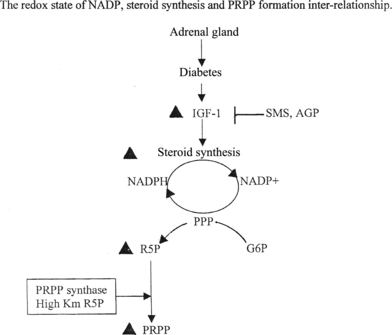Effects of long-acting somatostatin analogues on adrenal growth and phosphoribosyl pyrophosphate formation in experimental diabetes
- PMID: 22264286
- PMCID: PMC3311022
- DOI: 10.1111/j.1365-2613.2011.00801.x
Effects of long-acting somatostatin analogues on adrenal growth and phosphoribosyl pyrophosphate formation in experimental diabetes
Abstract
Adrenal growth and increased adrenal function occur in experimental diabetes. Previously, we have shown that phosphoribosyl pyrophosphate (PRPP) and PRPP synthetase increased rapidly between 3 and 7 days after induction of diabetes with streptozotocin (STZ), with less marked changes in enzymes of the pentose phosphate pathway. The present study examines the earlier phase of 1-3 days following induction of diabetes, seeking to elucidate whether control of PRPP production is a result of diabetic hyperglycaemia, or to a more general re-ordering of hormonal factors. To investigate this question, the role of insulin and two different long-acting somatostatin analogues, Angiopeptin and Sandostatin, were used in a well-established animal model. PRPP was chosen specifically as a target for these studies in view of its central role in nucleotide formation and nicotinamide mononucleotide synthesis via Nampt which is the rate-limiting step in the synthesis of NAD and which has been shown to have multiple roles in cell signalling in addition to its known function in glycolysis and energy production. Treatment with the somatostatin analogues ab initio effectively abolished the adrenal growth, the increase in PRPP formation and the rise of PRPP synthetase activity in the first 7 days of diabetes, without having any significant effect on blood glucose values. This suggests that elevated glucose per se is not responsible for the diabetic adrenal hypertrophy and implies that growth factors/hormones, regulated by somatostatin analogues, play a significant role in adrenal growth processes.
© 2012 The Authors. International Journal of Experimental Pathology © 2012 International Journal of Experimental Pathology.
Figures













 ; G6P dehydrogenase (units/g),
; G6P dehydrogenase (units/g),  ; GPG dehydrogenase (units/g),
; GPG dehydrogenase (units/g),  .
.
Similar articles
-
Effects of long-term experimental diabetes on adrenal gland growth and phosphoribosyl pyrophosphate formation in growth hormone-deficient dwarf rats.Int J Exp Pathol. 2012 Jun;93(3):196-201. doi: 10.1111/j.1365-2613.2012.00818.x. Int J Exp Pathol. 2012. PMID: 22583133 Free PMC article.
-
Effects of long-acting somatostatin analogues on redox systems in rat lens in experimental diabetes.Int J Exp Pathol. 2014 Apr;95(2):95-100. doi: 10.1111/iep.12069. Epub 2014 Mar 6. Int J Exp Pathol. 2014. PMID: 24602114 Free PMC article.
-
The effect of a somatostatin analogue (SMS 201-995, Sandostatin) on the concentration of phosphoribosyl pyrophosphate and the activity of the pentose phosphate pathway in the early renal hypertrophy of experimental diabetes in the rat.Biochem Med Metab Biol. 1988 Apr;39(2):226-33. doi: 10.1016/0885-4505(88)90080-1. Biochem Med Metab Biol. 1988. PMID: 2454125
-
Contribution of Model Organisms to Investigating the Far-Reaching Consequences of PRPP Metabolism on Human Health and Well-Being.Cells. 2022 Jun 13;11(12):1909. doi: 10.3390/cells11121909. Cells. 2022. PMID: 35741038 Free PMC article. Review.
-
Significance of the 5-phosphoribosyl-1-pyrophosphate pool for cardiac purine and pyrimidine nucleotide synthesis: studies with ribose, adenine, inosine, and orotic acid in rats.Cardiovasc Drugs Ther. 1998 Sep;12 Suppl 2:179-87. doi: 10.1023/a:1007704817774. Cardiovasc Drugs Ther. 1998. PMID: 9794092 Review.
Cited by
-
Effects of long-term experimental diabetes on adrenal gland growth and phosphoribosyl pyrophosphate formation in growth hormone-deficient dwarf rats.Int J Exp Pathol. 2012 Jun;93(3):196-201. doi: 10.1111/j.1365-2613.2012.00818.x. Int J Exp Pathol. 2012. PMID: 22583133 Free PMC article.
-
Effects of long-acting somatostatin analogues on redox systems in rat lens in experimental diabetes.Int J Exp Pathol. 2014 Apr;95(2):95-100. doi: 10.1111/iep.12069. Epub 2014 Mar 6. Int J Exp Pathol. 2014. PMID: 24602114 Free PMC article.
References
-
- Barbieri M, Bonafe M, Franceschi C, Paolisso G. Insulin/IGF-1-signaling pathway: an evolutionary conserved mechanism of longevity from yeast to humans. Am. J. Physiol. Endocrinol. Metab. 2003;285:E1064–E1071. - PubMed
-
- Becker MA. Phosphoribosylpyrophosphate synthase and the regulation of phosphoribosylpyrophosphate production in human cells. Prog. Nucleic Acid Res. Mol. Biol. 2001;69:115–148. - PubMed
-
- Becker MA, Raivio KO, Seegmiller JE. Synthesis of phosphoribosyl pyrophosphate in mammalian cells. Adv. Enzymol. Relat. Areas Mol. Biol. 1979;49:281–306. - PubMed
Publication types
MeSH terms
Substances
LinkOut - more resources
Full Text Sources
Miscellaneous

